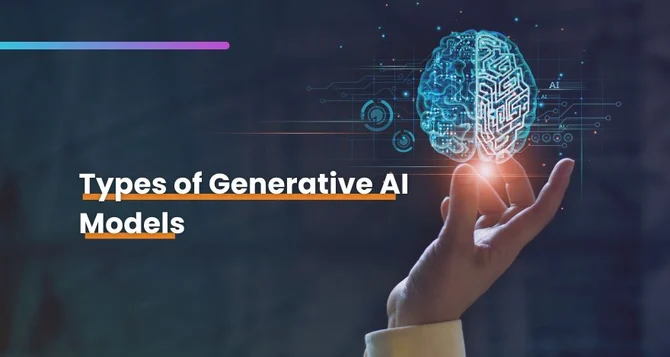
Generative AI is transforming creative industries, research, and business by producing realistic content that ranges from text and images to music and video. This capability is powered by specific types of generative models, each with unique architectures and advantages tailored to various applications. In this blog, we’ll dive into the main types of generative AI models—Generative Adversarial Networks (GANs), Variational Autoencoders (VAEs), Transformers, and Autoregressive Models—exploring how they work and the incredible possibilities they offer.
Generative Adversarial Networks (GANs)
Generative Adversarial Networks, or GANs, have become one of the most famous generative AI models, known for their ability to produce incredibly realistic images, videos, and even sounds.
How GANs Work:
GANs consist of two competing neural networks: a generator and a discriminator. The generator creates synthetic data (such as images), while the discriminator evaluates the authenticity of this data by distinguishing it from real samples. This adversarial process pushes the generator to improve with each iteration, refining its output until it can “fool” the discriminator into thinking the generated content is real.
Applications of GANs:
- Image Synthesis: GANs are used to create high-resolution, realistic images. This has applications in fashion, entertainment, and gaming.
- Video Generation: GANs can generate short video clips or improve video quality.
- Synthetic Data: GANs create synthetic data for training AI models, especially in fields with limited real data.
Popular examples include StyleGAN for high-quality face generation and CycleGAN for style transfer between image domains, such as turning photos into artistic styles.
Variational Autoencoders (VAEs)
Variational Autoencoders, or VAEs, are another popular class of generative models known for their unique encoding and decoding approach.
How VAEs Work:
VAEs compress input data into a lower-dimensional representation called the latent space. This space represents the data in a way that allows the model to capture and recreate key features when it reconstructs the original data. By sampling from this latent space, VAEs can generate new, diverse content that resembles the original dataset.
Applications of VAEs:
- Data Augmentation: VAEs create variations of existing data, useful for tasks like image recognition or anomaly detection.
- Medical Imaging: VAEs can enhance medical imaging by generating variations of scan data for diagnosis.
- Anomaly Detection: VAEs are useful in identifying data anomalies since they learn to represent the general structure of the data.
VAEs are particularly valuable when creating smooth, varied, and meaningful content is important, such as in healthcare, data science, and creative fields.
Transformers
Transformers have revolutionized the field of natural language processing (NLP) and are quickly expanding into other generative domains like image and multimodal content creation.
How Transformers Work:
Transformers use an attention mechanism that allows them to weigh the importance of each part of the input data, capturing complex relationships and dependencies. Unlike RNNs, which process data sequentially, transformers process entire sequences in parallel, making them highly efficient for large datasets and long inputs.
Applications of Transformers:
- Text Generation: Transformers are widely used for language generation in models like GPT (Generative Pre-trained Transformer), capable of producing human-like text.
- Image Generation: Transformer models like DALL-E generate images based on textual descriptions.
- Multimodal AI: Transformers also combine text and images, creating content that responds to multi-input formats.
With models like BERT, GPT-4, and T5, transformers have opened up vast possibilities in conversational AI, summarization, translation, and creative writing.
Autoregressive Models
Autoregressive models generate data sequentially, predicting each element based on previously generated ones. This approach is particularly effective in tasks that require maintaining context over a sequence, such as text, music, or time series generation.
How Autoregressive Models Work:
Autoregressive models generate one element at a time, using each new output as input for the next step. This sequential generation builds context, making these models especially good at producing cohesive and contextually accurate sequences.
Applications of Autoregressive Models:
- Text Generation: Language models like GPT and Transformer-based architectures often use autoregressive methods to produce coherent sentences.
- Audio Synthesis: Autoregressive models can produce realistic audio and music by predicting sound patterns over time.
- Time Series Prediction: These models are used in financial markets, weather forecasting, and any domain that requires prediction over time.
PixelCNN and WaveNet are examples of autoregressive models used in image and audio generation, respectively, making them effective tools in scenarios where sequential coherence is critical.
Choosing the Right Model: Matching Needs to Generative AI Architecture
Selecting the right generative model depends on the specific requirements of a project:
- For high-quality image generation or video content, GANs are often the best choice due to their ability to produce visually realistic outputs.
- VAEs work well in cases where data variation and augmentation are needed, as they excel at creating smooth, diverse outputs.
- If your focus is on natural language processing or multimodal tasks, transformers like GPT and BERT are ideal, thanks to their efficient handling of long sequences and context.
- For projects involving sequential data or time series like music, text, or audio synthesis, autoregressive models are highly effective due to their sequential generation capabilities.
The Future of Generative AI: Hybrid and Advanced Models
Generative AI is advancing rapidly, with new hybrid models that combine the strengths of different architectures. For instance, some models incorporate GANs and transformers to handle multimodal inputs, while others integrate VAEs with autoregressive techniques for better control over generated outputs. As these models evolve, they’re expected to bring even more sophisticated and customizable content generation capabilities across industries, making generative AI an indispensable tool for creators, researchers, and businesses.
